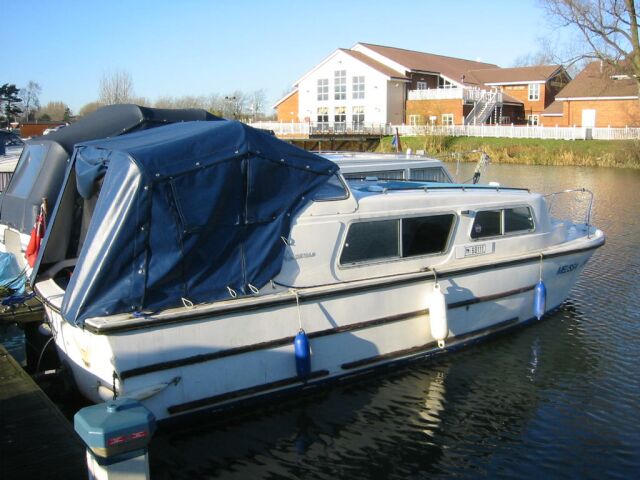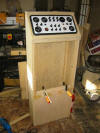
"MELISSA JANE"

Well it has been a great start. After owning the boat for 1 week, we now find it is 4 feet above the normal river level and we cannot get to it now. However, with some work we managed to tidy the boat up before the river rose and in fact it is better than we thought.
Melissa Jane a 23 foot Norman. Just for your interest, we think she was built in the mid 1970’s and I base that on the windows. They are all alloy and the ones over the forward part of the cabin are slightly smaller, but still alloy, not rubber insert types. She has a brand new canopy, solar cells and a few other little extras, but no shower or fridge.
Generally the boat is sound and the engine appears to be fine. We have three batteries on board (better than ballast) and at least 10 bags of ballast in the bow. There are solar charges in the windscreen area topping up the batteries.
I have installed a motor cycle battery charger to sort out the batteries because I found that a ‘marine’ one was about £180 but the motorcycle version is £39.99 and has intelligent charging even for Gel batteries. Rubbing strakes have to be renewed and a good rubbing down with abrasive compound should bring her hull back to life without too much problem. The canopy is new, but not well fitted, a few tweaks here and there with the tie downs will solve that.Power is supplied by a London Taxi 1500cc diesel engine, which is surprisingly quiet. Handling at the moment is awful, but then I have not attended to the ballast and it was a very windy day when I went out in her. Power to the prop is via a Enfield Z drive. She appears to be able to over rev too easily and I suspect a rather worn or damaged prop, which is also on the agenda.
The sun was shining and the weather was warm, no wind, no rain all was set to commence work on Melissa Jane our 23 foot newly acquired Norman cruiser. The plan for this year is to get the engine going well and to be able to start it without killing the battery each time. Three new batteries were purchased consisting of an 850 amp/hr CSS and two 110 amp/hr units for the general 12 volt system. That filled the LandRover and when loaded into the boat ballasted her very well to start with. Additionally a motor cycle computerised battery charger was purchased to trickle charge and ensure the batteries do not sulphate when left standing. We are lucky enough to have power to the moorings.
The charger is a little small for the job, but at £40 it is better than a £800 boat version and will still do the work but slowly. The old ‘photo-electric’ cells were taken from the boat which someone had installed previously. It would have taken forever to charge our batteries with a photocell system.
I started by ripping up all the flooring and wow, what a mess. I have never seen such a disgusting and potentially dangerous mass of wiring and this worried me as the boat was purchased with a BSS certificate valid to about 2005. In one 18” stretch of cable I found 6 joints in the bottom of the boat where gases could collect.
At the same time, I removed the Calor Gas cylinder and loose standing fire from ‘within’ the cabin. What exactly is this BSS anyway. The principle is sound but who are the inspectors?
It was then time decided to rip out the whole lot of wiring including the mains setup, which had many ‘taped up’ joints. Salvaging the consumer unit and a few sockets, we now start again. I also ripped out the engine wiring having found 1.5 household power cable to the ignition. It only got worse, when I found a bit of bell wire to the heater coils on the engine. Maybe the wire was the heater.
Finally I removed the steering console and again, I was mortified by what I found. Old wires with no protection and live where just hanging behind the console. A humorous item was the horn was wired to the spot light, which meant that when either the horn or light was activated, both worked, novel, must have been hell going through a long tunnel. It did not get better. The pictures below give an idea as to the state of the wiring.
I have now decided to renew all with modern wiring and high intensity LED’s cabin lights and a new split charge system with massive power switch.
As you know I am attacking the boat with a little bit of
vengeance, but I still want to get a seasons use out of her if possible without
too much problem, so I decided to work on the essentials. In this picture you
will see the rear of the Dash Board which has been
built from scratch. The base board is plastic with aluminium sandwich. This is
usually obtainable from your local 'exhibition display'
manufacturer.
I then laid out the board and set about wiring it together. The reason I did
this was that the wiring was in a bad way and had been butchered over the years
with add ons. I do not fancy a fire on a boat.
Stage 2, make the control panel for the dashboard. Woodwork is not my strongest ability and after starting ply and making a hash of it, I decided to revert to timber and later treat it with stain etc. The result without stain is in the picture
The dash board will be placed into the module and secured to the cabin bulk head
The dash is in place and note that I have left hatches at the front for easy access. The wheel will fit on the top part and later the bottom will have a foot rest built in.

A point of interest, I purchased a new wheel for £50 at Kitcheners
Marine (one of a very few Inland Waterways own shops) and it fits the
Norman beautifully, but you will have to wait for that picture
So with new ‘glow plugs’ for our BMC Taxi engine and a new porta loo we will be away as soon as the water subsides.
This is a picture of the wheel and control housing before I converted to wood. I will send a picture later with the new housing and new wheel. If anyone would like to make an offer for the wheel, which is in need of some restoration, let me know as I have replaced it with a substitute, heaven forbid!
Another picture from the project. I have now installed the dashboard and pod together with the controls and the new wheel. When I bought the boat it was a devil to start and I thought it was the wiring to glow plugs (being a diesel engine), so I changed everything, but as the law of 'Murphy’ goes, it was found that the poor starting was a loose joint on the diesel line. Oh well, that will teach me not to check everything
On the project another interesting item found today. The drive belt for the Jabsco appeared a little loose, so with good will I decided to tighten it a little. No adjustment facility, ehm? I did however find that a bolt had sheered and that was causing the looseness. All sorted now, but don’t like the lack of adjustment.
Pictures attached of the alternator which I had checked out. It is fine and now replaced. Getting nearer to moving off the mooring.
Its amazing how such a small thing
can really ruin your day. I decided yesterday to take Melissa Jane out for a
spin on a beautiful sunny Sunday. Down to the marina, uncover the boat and with
coffee flask in hand (not yet got round to connecting the gas bits) start the
engine. Second time she fired up and away we go. A small touch of reverse to
sort out the mooring and away to open river.
Not so, no reverse and coming to that, no forward now either. Oh dear, a quick
look over the stern (the blunt end for those new to boating) and there ominously
was a cable swinging in the breeze, it was the gear cable. Well with
unimaginable skill (not me, others avoiding me) we managed to return to the
moorings, some 10 feet away, some trip. Further examination revealed that the
tiny gear lever on the Enfield stern drive had broken off. What had I hit I
thought, then it suddenly dawned on me, electrolytic activity was the culprit.
Because the lever is under the water and the good old well know electric problem
it had worn out the end of the lever (picture attached, see the small end that
has broken off) because there is no sacrificial anode on the boat, must get one.
No problem, a pair of waders (what a sight) and a few tools the gear lever was
removed. Now for the half moon key in the spline no problem, oh no a minute wave
washed it out of the slot x#x#x#x#. Never mind the Sea Searcher (big magnet, not
a diver) was called for and after two seconds, the key was found together with a
spanner, old hypo syringe and
some nuts and bolts.
To cut a long story short, new (well modified second hand motor cycle gear)
lever fitted courtesy of the waders and we are away again ready for the next
problem, oh boy what a joy is this boating lark